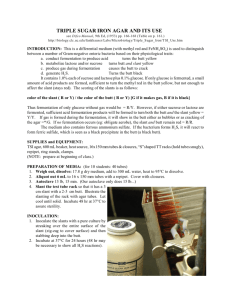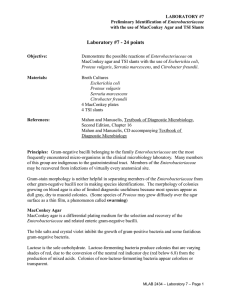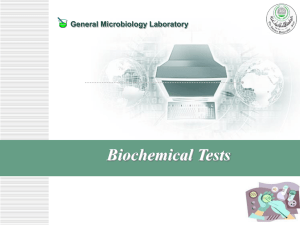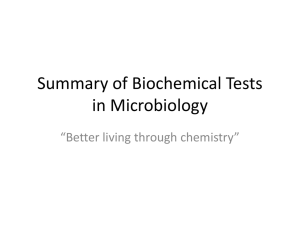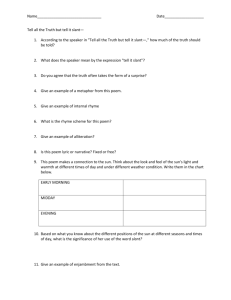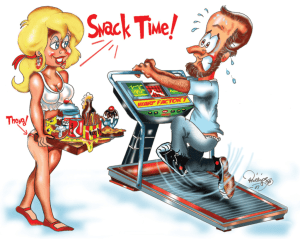Triple Sugar Iron info 1
advertisement
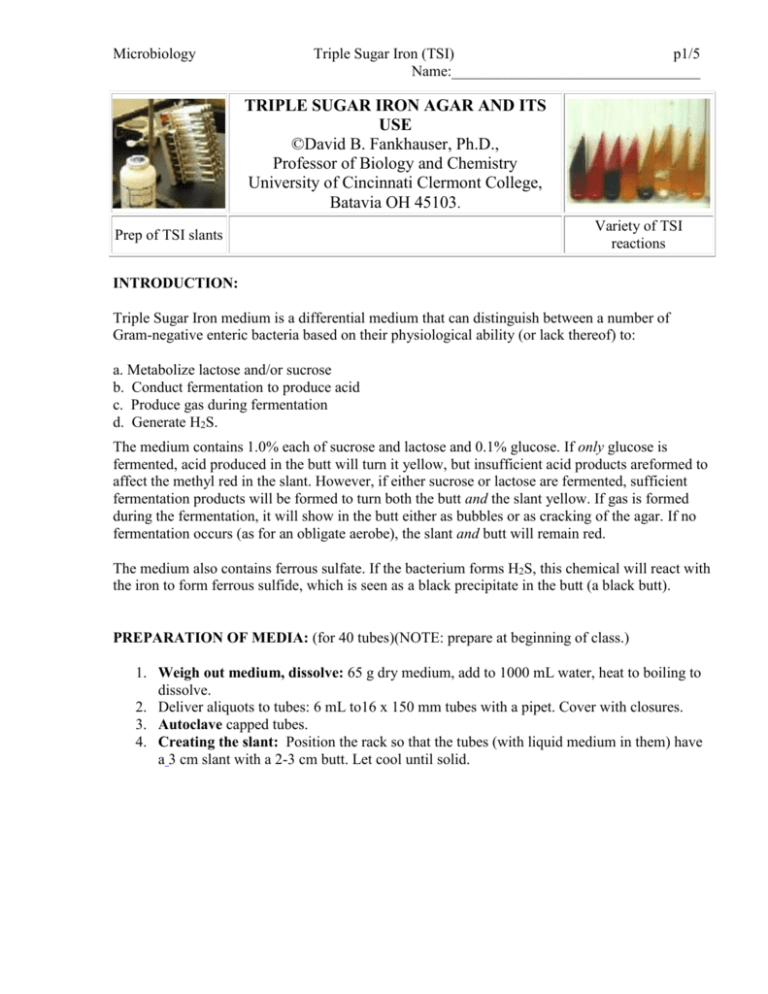
Microbiology Triple Sugar Iron (TSI) p1/5 Name:_________________________________ TRIPLE SUGAR IRON AGAR AND ITS USE ©David B. Fankhauser, Ph.D., Professor of Biology and Chemistry University of Cincinnati Clermont College, Batavia OH 45103. Prep of TSI slants Variety of TSI reactions INTRODUCTION: Triple Sugar Iron medium is a differential medium that can distinguish between a number of Gram-negative enteric bacteria based on their physiological ability (or lack thereof) to: a. Metabolize lactose and/or sucrose b. Conduct fermentation to produce acid c. Produce gas during fermentation d. Generate H2S. The medium contains 1.0% each of sucrose and lactose and 0.1% glucose. If only glucose is fermented, acid produced in the butt will turn it yellow, but insufficient acid products areformed to affect the methyl red in the slant. However, if either sucrose or lactose are fermented, sufficient fermentation products will be formed to turn both the butt and the slant yellow. If gas is formed during the fermentation, it will show in the butt either as bubbles or as cracking of the agar. If no fermentation occurs (as for an obligate aerobe), the slant and butt will remain red. The medium also contains ferrous sulfate. If the bacterium forms H2S, this chemical will react with the iron to form ferrous sulfide, which is seen as a black precipitate in the butt (a black butt). PREPARATION OF MEDIA: (for 40 tubes)(NOTE: prepare at beginning of class.) 1. Weigh out medium, dissolve: 65 g dry medium, add to 1000 mL water, heat to boiling to dissolve. 2. Deliver aliquots to tubes: 6 mL to16 x 150 mm tubes with a pipet. Cover with closures. 3. Autoclave capped tubes. 4. Creating the slant: Position the rack so that the tubes (with liquid medium in them) have a 3 cm slant with a 2-3 cm butt. Let cool until solid. Microbiology Triple Sugar Iron (TSI) p2/5 Name:_________________________________ INOCULATION: 1. Inoculate the slants using a pure culture with a stab by streaking over the entire surface of the slant (zig-zag to cover surface)and then stabbing deep into the butt. 1. Inoculate 3 TSI tubes one each of: 1. Escherichia coli 2. Pseudomonas aeruginosa 3. Salmonella typhimurium 2. Incubate at 37ºC for 24 hours (48 hr may be necessary to show all H2S reactions). TRIPLE SUGAR IRON AGAR: INTERPRETATION OF RESULTS SCORING THE SLANTS: Examine the slant and butt, and record data using the following criteria: SLANT COLOR: Code letter: Interpretation Example RED does not ferment either lactose or sucrose Example red slant R YELLOW Y ferments lactose and/or sucrose Example yellow slant SCORING THE BUTT COLOR AND CONDITION: BUTT Code Interpretation Example COLOR/CONDITION Letter no fermentation, the bacterium is RED Example red butt R an obligate aerobe Y some fermentation has occurred, acid has been produced, it is a Example yellow butt facultative anaerobe. GAS FORMED YG Seen as cracks in the agar, bubbles, or the entire slant may be pushed out of the tube. Example yellow butt with gas (Caution: these gassy fermenters may have bacteria close to the opening.) BLACK "+" H2S has been produced YELLOW Example black butt Microbiology Triple Sugar Iron (TSI) p3/5 Name:_________________________________ After you have scored your TSI Agar slants, you should suggest a species of bacterium which matches those metabolic traits discovered. While by no means definitive, the following are TSI Agar reactions typical of a number of prominent species which can be distinguished by this medium: Score your cultures BACTERIUM SLANT BUTT H2S COMMENTS Salmonella typhimurium Escherichia coli Pseudomonas aeruginosa ACTION indicate with +/Ferments Glucose Ferments Lactose Produces Gas Produces H2S Salmonella typhimurium Escherichia. coli Pseudomonas aeuginosa Microbiology Triple Sugar Iron (TSI) p4/5 Name:_________________________________ TYPICAL REACTIONS OF SELECTED ENTERICBACTERIA: BACTERIUM SLANT BUTT H2S COMMENTS Shigella dysenteriae R Y Causes food infection dysentery Salmonella typhimurium R YG + Causes food poisoning Salmonella typhi R Y + Causes typhoid fever Aerobacter aerogenes Y YG Similar to Klebsiella,but nonrespiratory Escherichia coli Y YG Most common of GIflora Citrobacter freundii Y YG + Proteus vulgaris Y YG + Causes GU infections, highly motile Klebsiella pneumoniae Y R or YG Pneumonia in debilitated patients (nosocomial) Pseudomonas aeruginosa R R GI inhabitant, causes wound, GU infections Alcaligenes faecalis R R GI inhabitant, opportunistic pathogen of GU one of "paracolon" group (non-pathogenic) Uninoculated R/R Obligate aerobe R/Y +;Glucose fermented H2S gas formed R/Y; Only Glucose fermented Y/Y +; Lactose + / or Sucrose fermented & H2S Y/Y G; Lactose + / or Sucrose fermented & Gas Y/Y G; Lactose + / or Sucrose fermented & Gas Y/Y ; Lactose + / or Sucrose fermented & No Gas Microbiology Example of Yellow Butt Y Triple Sugar Iron (TSI) p5/5 Name:_________________________________ Yellow Butt with Gas YG Black Butt H2S Gas Yellow Slant Red Butt/ Red Slant Red Slant
